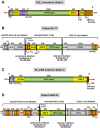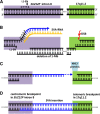SVA retrotransposon insertion-associated deletion represents a novel mutational mechanism underlying large genomic copy number changes with non-recurrent breakpoints
- PMID: 24958239
- PMCID: PMC4229983
- DOI: 10.1186/gb-2014-15-6-r80
SVA retrotransposon insertion-associated deletion represents a novel mutational mechanism underlying large genomic copy number changes with non-recurrent breakpoints
Abstract
Background: Genomic disorders are caused by copy number changes that may exhibit recurrent breakpoints processed by nonallelic homologous recombination. However, region-specific disease-associated copy number changes have also been observed which exhibit non-recurrent breakpoints. The mechanisms underlying these non-recurrent copy number changes have not yet been fully elucidated.
Results: We analyze large NF1 deletions with non-recurrent breakpoints as a model to investigate the full spectrum of causative mechanisms, and observe that they are mediated by various DNA double strand break repair mechanisms, as well as aberrant replication. Further, two of the 17 NF1 deletions with non-recurrent breakpoints, identified in unrelated patients, occur in association with the concomitant insertion of SINE/variable number of tandem repeats/Alu (SVA) retrotransposons at the deletion breakpoints. The respective breakpoints are refractory to analysis by standard breakpoint-spanning PCRs and are only identified by means of optimized PCR protocols designed to amplify across GC-rich sequences. The SVA elements are integrated within SUZ12P intron 8 in both patients, and were mediated by target-primed reverse transcription of SVA mRNA intermediates derived from retrotranspositionally active source elements. Both SVA insertions occurred during early postzygotic development and are uniquely associated with large deletions of 1 Mb and 867 kb, respectively, at the insertion sites.
Conclusions: Since active SVA elements are abundant in the human genome and the retrotranspositional activity of many SVA source elements is high, SVA insertion-associated large genomic deletions encompassing many hundreds of kilobases could constitute a novel and as yet under-appreciated mechanism underlying large-scale copy number changes in the human genome.
Figures





Similar articles
-
Identification of recurrent type-2 NF1 microdeletions reveals a mitotic nonallelic homologous recombination hotspot underlying a human genomic disorder.Hum Mutat. 2012 Nov;33(11):1599-609. doi: 10.1002/humu.22171. Epub 2012 Aug 20. Hum Mutat. 2012. PMID: 22837079
-
Decoding NF1 Intragenic Copy-Number Variations.Am J Hum Genet. 2015 Aug 6;97(2):238-49. doi: 10.1016/j.ajhg.2015.06.002. Epub 2015 Jul 16. Am J Hum Genet. 2015. PMID: 26189818 Free PMC article.
-
A novel third type of recurrent NF1 microdeletion mediated by nonallelic homologous recombination between LRRC37B-containing low-copy repeats in 17q11.2.Hum Mutat. 2010 Jun;31(6):742-51. doi: 10.1002/humu.21254. Hum Mutat. 2010. PMID: 20506354
-
A mobile threat to genome stability: The impact of non-LTR retrotransposons upon the human genome.Semin Cancer Biol. 2010 Aug;20(4):211-21. doi: 10.1016/j.semcancer.2010.03.001. Epub 2010 Mar 20. Semin Cancer Biol. 2010. PMID: 20307669 Free PMC article. Review.
-
Origins and breakpoint analyses of copy number variations: up close and personal.Cytogenet Genome Res. 2011;135(3-4):271-6. doi: 10.1159/000330267. Epub 2011 Aug 12. Cytogenet Genome Res. 2011. PMID: 21846967 Review.
Cited by
-
The cancer-associated CTCFL/BORIS protein targets multiple classes of genomic repeats, with a distinct binding and functional preference for humanoid-specific SVA transposable elements.Epigenetics Chromatin. 2016 Aug 31;9(1):35. doi: 10.1186/s13072-016-0084-2. eCollection 2016. Epigenetics Chromatin. 2016. PMID: 27588042 Free PMC article.
-
Can Designer Indels Be Tailored by Gene Editing?: Can Indels Be Customized?Bioessays. 2019 Dec;41(12):e1900126. doi: 10.1002/bies.201900126. Epub 2019 Nov 6. Bioessays. 2019. PMID: 31693213 Free PMC article.
-
Cancer mutational burden is shaped by G4 DNA, replication stress and mitochondrial dysfunction.Prog Biophys Mol Biol. 2019 Oct;147:47-61. doi: 10.1016/j.pbiomolbio.2019.03.004. Epub 2019 Mar 14. Prog Biophys Mol Biol. 2019. PMID: 30880007 Free PMC article.
-
Genotype-Phenotype Associations in Patients With Type-1, Type-2, and Atypical NF1 Microdeletions.Front Genet. 2021 Jun 8;12:673025. doi: 10.3389/fgene.2021.673025. eCollection 2021. Front Genet. 2021. PMID: 34168676 Free PMC article.
-
New Understanding of the Relevant Role of LINE-1 Retrotransposition in Human Disease and Immune Modulation.Front Cell Dev Biol. 2020 Aug 7;8:657. doi: 10.3389/fcell.2020.00657. eCollection 2020. Front Cell Dev Biol. 2020. PMID: 32850797 Free PMC article. Review.
References
-
- Kluwe L, Siebert R, Gesk S, Friedrich RE, Tinschert S, Kehrer-Sawatzki H, Mautner V-F. Screening of 500 unselected neurofibromatosis 1 patients for deletions of the NF1 gene. Hum Mutat. 2004;23:111–116. - PubMed
-
- Kehrer-Sawatzki H, Cooper DN. In: Neurofibromatosis Type 1, Molecular and Cellular Biology. Upadhyaya M, Cooper DN, editor. Heidelberg: Springer; 2012. NF1 microdeletions and their underlying mutational mechanisms; pp. 187–211.
-
- Dorschner MO, Sybert VP, Weaver M, Pletcher BA, Stephens K. NF1 microdeletion breakpoints are clustered at flanking repetitive sequences. Hum Mol Genet. 2000;9:35–46. - PubMed
-
- López-Correa C, Dorschner M, Brems H, Lazaro C, Clementi M, Upadhyaya M, Dooijes D, Moog U, Kehrer-Sawatzki H, Rutkowski JL, Fryns JP, Marynen P, Stephens K, Legius E. Recombination hotspot in NF1 microdeletion patients. Hum Mol Genet. 2001;10:1387–1392. - PubMed
Publication types
MeSH terms
Substances
Associated data
- Actions
LinkOut - more resources
Full Text Sources
Other Literature Sources
Molecular Biology Databases
Research Materials
Miscellaneous

